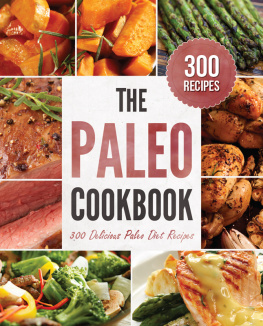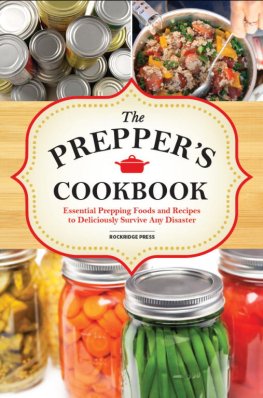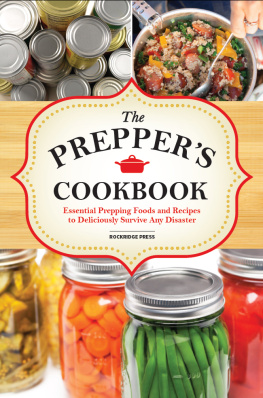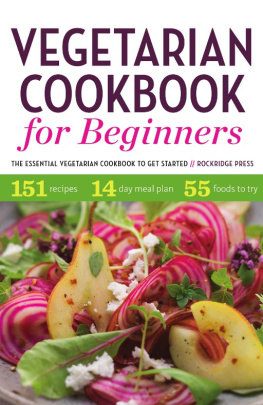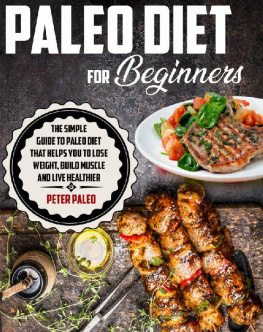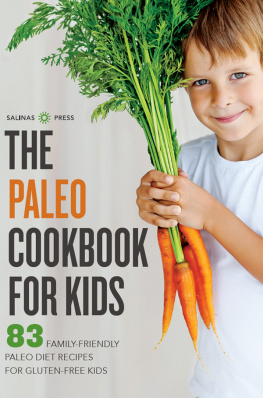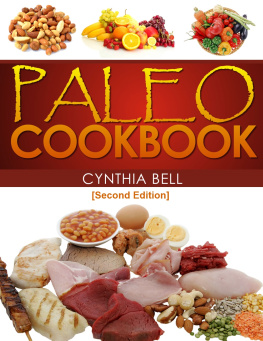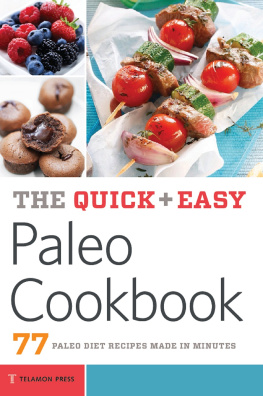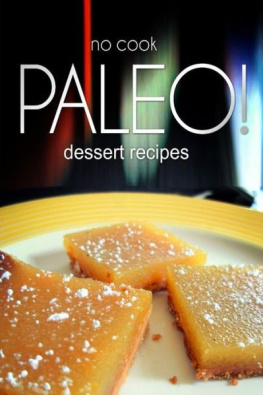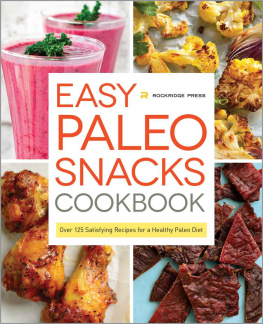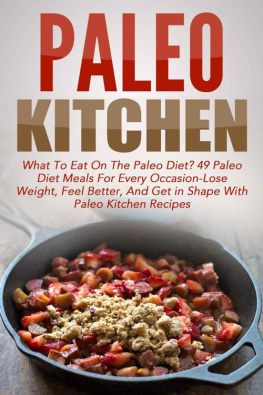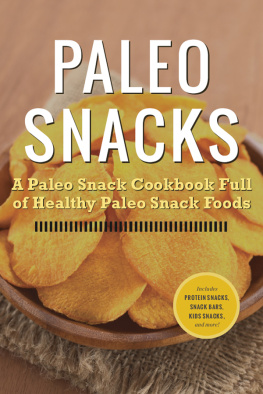
WHAT IS THE PALEO DIET?
T he Paleo diet has become incredibly popular in the past few years, leading many people to assume that its a new way of eating. In reality, the Paleo diet has been around for almost forty years.
How the Paleo Diet Came About
In 1975, a gastroenterologist named Dr. Walter Voegtlin published a book called The Stone Age Diet. In the book, he documented how he treated patients with a diet that replicated the eating patterns of people during the Paleolithic era. The diet prescribed consuming large quantities of animal fats and proteins and very small quantities of carbohydrates. Dr. Voegtlin reported that his patients, who suffered from disorders such as Crohns disease and irritable bowel syndrome, showed significant health improvements when following the diet.
Unfortunately, The Stone Age Diet didnt make much headway with the public. At that time, almost everyone believed that a low-fat, low-calorie diet was the only healthy way to eat.
An Ancient Diet for Modern Times
Ten years later, however, Dr. S. Boyd Eaton and Dr. Melvin Konner published a paper in The New England Journal of Medicine that supported Dr. Voegtlins research and that received a lot of attention from the medical community and the media. The popularity of their paper on the Paleolithic era diet led to the publication of their book, The Paleolithic Prescription: A Program of Diet & Exercise and a Design for Living. This book established the principles most variations of the Paleo diet people follow today.
The book explained the way our Paleolithic ancestors ate and why that nutritional lifestyle was such a healthy one. The most important thing the authors accomplished was to make the ancient diet suitable for modern times. The book laid out the nutritional content of the original Paleolithic diet and then showed readers how to get that nutritional profile from modern and widely available foods. It was an adaptable way to eat like our ancestors, and it paved the way for todays Paleo diet phenomenon.
The Paleo Diet for You, the Modern Cave-Dweller
There are several versions of the Paleo diet around today; these versions generally differ in terms of how strictly they follow the eating patterns of our Paleolithic ancestors. The Paleo diet described in this book is a version that intends to closely duplicate the nutritional makeup of a Paleolithic diet without being unrealistic, difficult or complicated. Youll reap the health and weight loss benefits of the Paleo diet without having to turn your entire lifestyle inside out or spend time searching for exotic ingredients. Youll be practicing a diet that is moderate in its approach, but you will likely see incredible results.
What the Paleo Diet Looks Like
The Paleo diet is designed to duplicate the results and benefits of our pre-agricultural diet without duplicating the diets prehistoric methods. While there are a few Paleo followers who do literally hunt, gather or forage all of their food, most people dont have the motivation or time for that level of authenticity. Fortunately, we can achieve the same Paleolithic results with foods readily available to us in grocery stores, health foods stores and farmers markets.
The Paleo diet food pyramid is an inverted version of the one that used to be recommended by the USDA. Meats, eggs and seafood make up the majority of the days calories, followed by fats from plant foods, fruits and vegetables, and then nuts and seeds. The Paleo diet is a high-protein/low-carbohydrate diet.
In , we go into more detail on what youll be eating from each food group and also give you a specific list of allowed (and disallowed) foods. For now, well cover the basics.
What Is Not on Your Paleo Plate?
The Paleo diet is effective not only because of what you eat, but also because of what you dont eat. Changing the components and proportions of your diet is only half of the Paleo plan. The other half involves eliminating foods that can slow your metabolism, encourage blood sugar problems and fat storage, and slow digestion. These eliminated foods include processed foods, alcohol, grains, legumes and sugar.
Processed Foods
Fast food, frozen meals and store-bought sweets and snacks are not a part of the Paleo diet and should be avoided.
Grains
Grains, including all breads, pasta, rice, oats and barley, are agricultural products; you are embarking on a pre-agricultural diet. Later in this chapter, well explain in greater detail why grains are specifically off-limits.
Legumes
As with grains, legumes such as beans, peas, soy and soy derivatives are agricultural products and are therefore off-limits. Well explain the specific risks to your health that these foods pose later in this chapter.
Sugar
One of the remarkable things about the Paleo diet is the impact it can have not only on lowering blood sugar levels, but also on decreasing your risk of developing diabetes and metabolic syndrome. In part, this is because sugars are eliminated on the Paleo diet. It is also very important to avoid substituting artificial sweeteners for sugar. You can, however, use honey in moderation, as it was likely a part of the ancestral diet. Chocolate may be consumed, but choose unsweetened and dark varieties.
What Is on Your Paleo Plate?
Meats, Eggs and Seafood
This food group is where you will get most of your calories. All meat, fish, shellfish, mollusks, and eggs are allowed, but there are some guidelines for choosing the right foods for the best results. The most important thing is that these foods are of high quality and are prepared with Paleo-approved ingredients.
Fats from Plant Sources
These sources include olives and olive oil, avocadoes (which are a fruit but serve as a fat), and nuts and seeds (which are described in detail in the next section). Since butter is a dairy product and does not improve your heart health, it should be avoided when cooking or preparing foods; use pure olive oil for cooking and grapeseed oil or extra virgin olive oil for uncooked dressings.
Nuts and Seeds
Nuts and seeds were a big part of the Paleolithic-era diet. All nuts are allowed, with the exception of peanuts, which are a legume. Seeds are allowed, including flax seeds, sunflower seeds, pumpkin seeds, sesame seeds and others. If you are frightened by the idea of giving up pasta and rice, the good news is that quinoa is allowed. Not only is quinoa a seed, but it also makes a great substitute for rice, pasta, oats, barley and other grain foods.
Fruits and Vegetables
The fruits allowed on the Paleo diet are those that would have been readily available (foraged) in the pre-agricultural era. These foraged fruits include berries, such as cranberries, raspberries, strawberries and blueberries. Tree fruits are also a mainstay of the Paleo diet; they include citrus fruits, apples, peaches, plums, cherries, nectarines and pears.
Choose vegetables that can be foraged in the wild. This eliminates most root vegetables, such as potatoes, sweet potatoes, carrots and parsnips, but includes wild root vegetables. Foraged vegetables include lettuces and leafy greens, tomatoes, peppers, squash and zucchini.
Condiments
Some condiments are allowed, but they should be limited to those that do not contain sugar or any of the forbidden ingredients. Ketchup, for example, is not allowed; mustard, on the other hand, is made from seeds and usually does not contain added sugar. In general, try to rely on herbs and spices rather than condiments.
Beverages
Allowed beverages include pure fruit and vegetable juices, but they should be unsweetened versions and consumed in moderation. Water should be your primary beverage. Tea and coffee are acceptable on the Paleo diet, as long as you use almond milk to lighten them, rather than dairy milk. Alcohol should be consumed only occasionally, and always choose gluten-free beer or hard ciders if you want to imbibe. Some recipes in this book call for organic wines, as they dont contain sulfites or other additives.
Next page
